The arrival of fall invites a beautiful transformation in our gardens, offering an excellent opportunity to experiment with a range of captivating plants. On this page, we will explore outstanding plants that not only thrive in pots but also add unique colors and textures perfect for the autumn season.
Asters
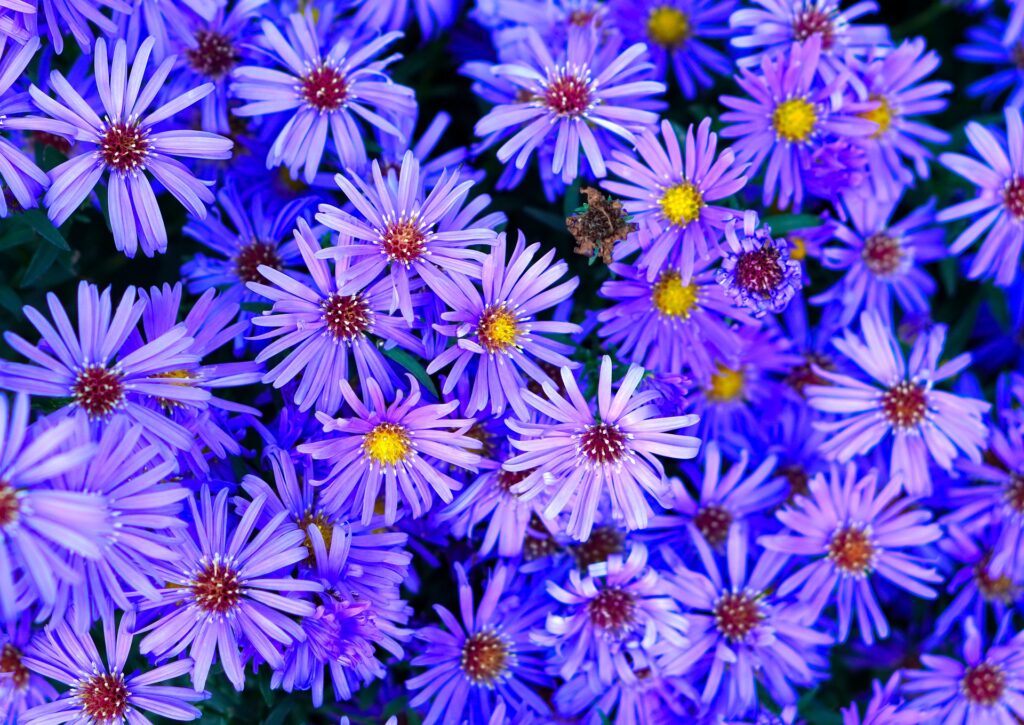
While the singular “Aster” captures a lovely plant, let’s explore “Asters,” referring to the variety of species within this genus that gardeners can delight in. Each species offers unique colors, heights, and foliage types, adding depth and texture to your fall planter arrangements. The diversity among Asters means that combining different types can create a rich tapestry of color and form.
Consider the New England Aster (Symphyotrichum novae-angliae), known for its tall stature and robust blooms. This species can grow up to four feet tall and looks stunning when paired with shorter plants. It thrives in slightly moist soil, making it a great candidate for mixed containers or as a back row plant in larger arrangements. Alternatively, the Sky Blue Aster (Symphyotrichum oolentangiense) offers a softer color palette with its serene blue flowers that contrast beautifully against autumn foliage.
Using Asters in pots allows for creative placement throughout your yard or on your balcony. They can serve as eye-catching focal points or be mixed with perennials and annuals such as ornamental peppers or kale for a rich fall display. The varying shapes and sizes of the different Asters provide an excellent opportunity to experiment with height and color, ensuring your fall pots are not only alive with blooms but telling an artistic story.
Begonia
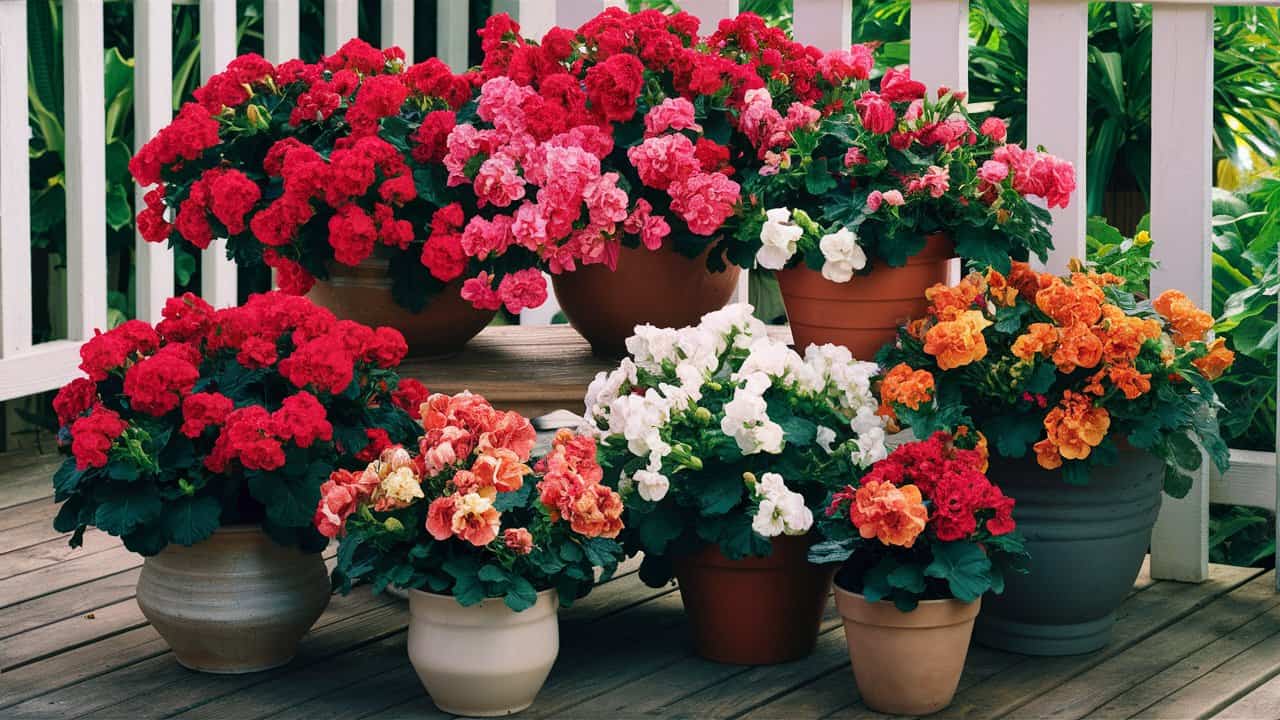
The Begonia, a celebrated fall plant for pots, showcases lush foliage and stunning flowers, making it an excellent choice for autumn décor. While commonly associated with warmer months, specific varieties, such as the Begonia x tuberhybrida, perform well during the fall season and can withstand cooler temperatures if protected from frost. Their versatility allows them to thrive in both sun and shade, making them an adaptable option for containers placed in various locations around your home.
When selecting begonias for your fall pots, consider the impressive Rex begonias, known for their stunning leaf patterns and colors. These foliage plants can be paired with flowering varieties to create arrangements that are both visually stimulating and texturally rich. The foliage of Rex begonias showcases deep purples, silvers, and reds that provide an excellent backdrop for later-blooming flowers.
To ensure your begonias flourish in pots during the fall, prioritizing proper drainage is vital. Begin with a quality potting mix, and consider adding perlite or gravel to enhance drainage. Positioning your pots in spots that receive morning sun and afternoon shade will help to maintain their vibrant colors while keeping the plants hydrated. Regular watering is essential, but be cautious not to oversaturate the soil. With the right care, Begonias can beautifully extend your garden’s color palette into fall, creating a warm and inviting atmosphere.
Black-Eyed Susans
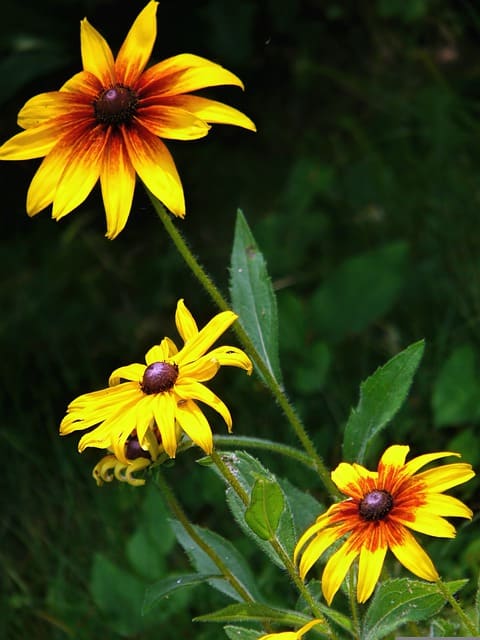
The cheerful Black-Eyed Susan (Rudbeckia hirta) is a timeless autumn perennial that can breathe life into your fall pots. These bright golden-yellow flowers with distinct dark centers are known for their resilience and can bloom well into the fall if properly cared for. They thrive in full sun, making them perfect for outdoor spaces where sunlight is abundant as the season transitions.
When choosing Black-Eyed Susans for your pots, consider selecting a mix of dwarf varieties, such as ‘Little Gold Star’ or ‘Goldsturm’. These compact versions will stay under two feet tall, allowing them to present a delightful display without overwhelming smaller pots. Additionally, pairing them with other fall favorites, like ornamental grasses or purple petunias, creates a vibrant contrast that enhances their sunny disposition.
To keep your Black-Eyed Susans flourishing, ensure you water them regularly, especially during periods of dry weather. Deadheading spent blooms encourages more flower production, extending their vibrant display as the days shorten. Finally, they are excellent for attracting pollinators, turning your pots into a lively hub of activity as bees and butterflies continue to seek out their nectar through the mild fall months.
Bugleweed
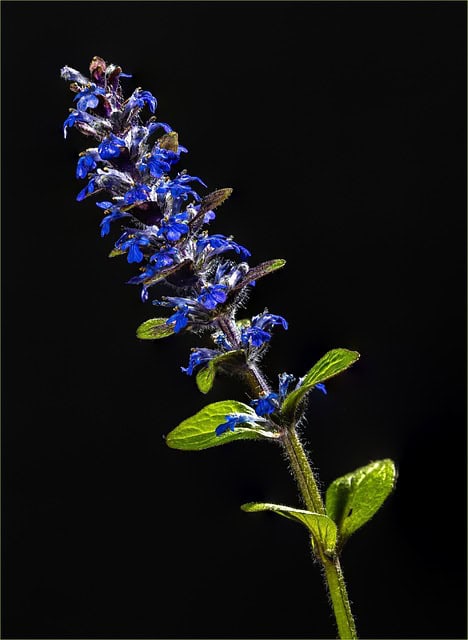
Bugleweed (Ajuga reptans) is an often-overlooked gem when it comes to fall container gardening. Renowned for its low-growing, sprawling habit, Bugleweed is not only an essential ground cover but also makes an exquisite addition to pots due to its eye-catching foliage and delightful spikes of purple flowers that bloom late in the season. Its foliage can range from deep green to variegated shades of cream and purple, providing texture and dimension to any fall arrangement.
When selecting Bugleweed for containers, look for cultivars such as ‘Chocolate Chip’ or ‘Burgundy Glow’, which remain compact and showcase a rich array of leaf color. These varieties are particularly attractive when combined in pots with other fall plants, creating a visually appealing contrast. Bugleweed thrives in both sun and shade, making it an adaptable option for planters placed in different light conditions.
One of the key advantages of Bugleweed is its ability to retain soil moisture, reducing the need for frequent watering. However, it’s wise to ensure proper drainage in your pots to prevent root rot. As the weather cools, maintaining a well-drained potting mix is crucial to help Bugleweed settle in and flourish, enhancing the overall beauty of your fall plant displays.
Celosia
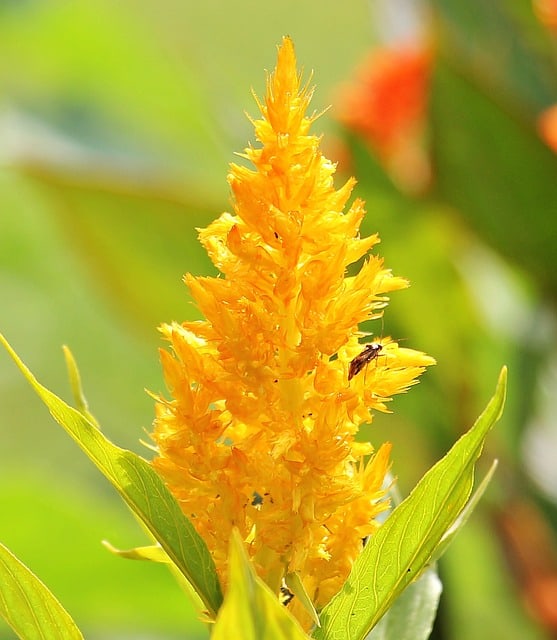
Celosia is an exotic and vibrant choice for adding flair to your fall pots. Known for its unique plume-like flowers and bright colors—ranging from fiery reds to sunny yellows—Celosia can also introduce a fun texture to your container gardens. Whether you opt for the feathery cockscomb variety or the spiky, wheat-like heads of Celosia argentea, these plants are sure to capture attention and create a dramatic visual impact.
For pots, various Celosia varieties such as ‘Celosia Cristata’ (cockscomb) or ‘Celosia Spicata’ (plume) work particularly well, with many forms boasting an impressive height of 12 to 24 inches. They thrive in full sun conditions, making them ideal for areas that receive abundant light during the fall. Celosia is also known for its drought tolerance; however, consistent moisture is essential for optimal growth, particularly in pots.
Celosia can be used to add playfulness to your autumn displays. Pair it with deep purple pansies or ornamental cabbage for a lively contrast, or with muted greens and yellows for a sophisticated, monochromatic look. Their blooms can last for weeks, enduring even light frosts, and enhancing the beauty of your fall pots well into late autumn.
Chrysanthemums
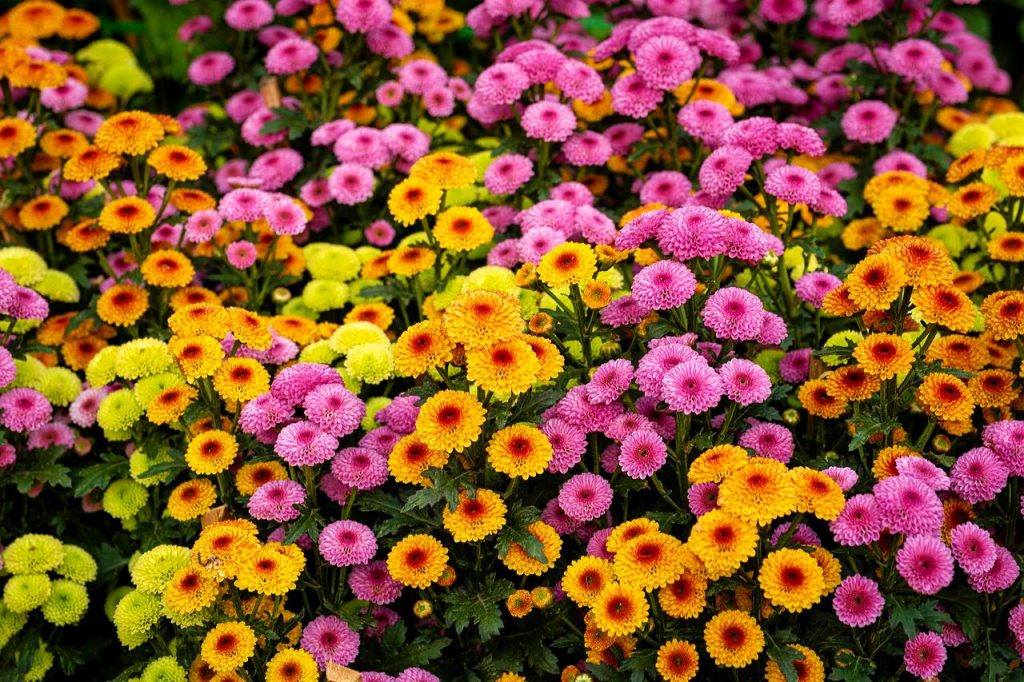
Chrysanthemums, or “mums,” are among the most beloved fall flowers, recognized for their burst of color and variety in shape and size. Often seen in garden centers during autumn, these resilient perennials can elevate any pot’s visual appeal. Their flowers come in a stunning array of colors, including deep reds, purples, vibrant oranges, and sunny yellows, making them a versatile choice for complementing your seasonal décor.
When planting chrysanthemums in pots, select varieties that are suited for container gardening, such as ‘Garden Mum’ or the compact ‘Marinette’. These categories maintain a manageable height of about 12 to 18 inches, perfect for smaller pots. In terms of care, consistent watering is essential—mums prefer moist, well-drained soil. To maximize their blooming period, consider bonding them with cold-weather companions like ornamental kale or pansies, which provide an enchanting contrast as the fall progresses.
Additionally, chrysanthemums are known to thrive in full sun, so place your pots in an area that receives at least six hours of sunlight each day. A light application of fertilizer can also promote vigorous blooms, ensuring that your containers remain a vibrant celebration of fall’s arrival until the first frost.
Coleus
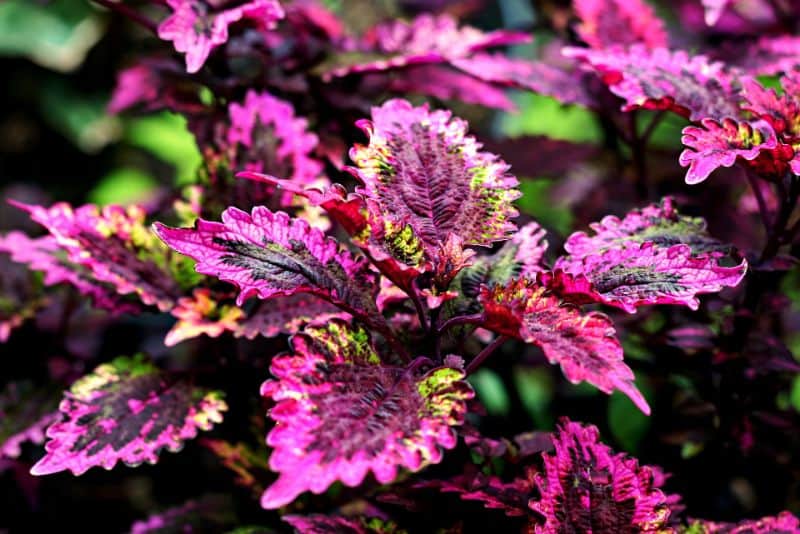
Coleus plants are admired for their striking foliage, which can transform any fall container garden into a vivid display. Known for their vibrant colors and unique leaf shapes, Coleus offers an array of patterns encompassing reds, greens, yellows, purples, and even black. While typically associated with summer, many varieties are perfectly suited for fall pot displays, providing a rich backdrop for other autumnal blooms.
When choosing Coleus for pots, opt for varieties such as ‘Dark Mosaic’ or ‘Kong® Red,’ which showcase stunning leaves that can stand alone as a focal point. These plants do well in partial shade, making them a fantastic option for those areas of your home that receive less direct sunlight during the fall months. Be mindful that Coleus is sensitive to cold temperatures, so if chilly nights are expected, it’s advisable to bring pots indoors or cover them to protect them from frost.
Pairing Coleus with flowering plants like Chrysanthemums or asters not only creates a spectacular visual contrast but also adds depth to your arrangements. Ensure that your Coleus receives regular watering—while they enjoy moisture, it is vital to avoid waterlogging, as this can lead to root rot. With their lush, colorful leaves, Coleus will undoubtedly enhance your fall pots, making your outdoor space an inviting retreat during the crisp autumn days.
Coneflower
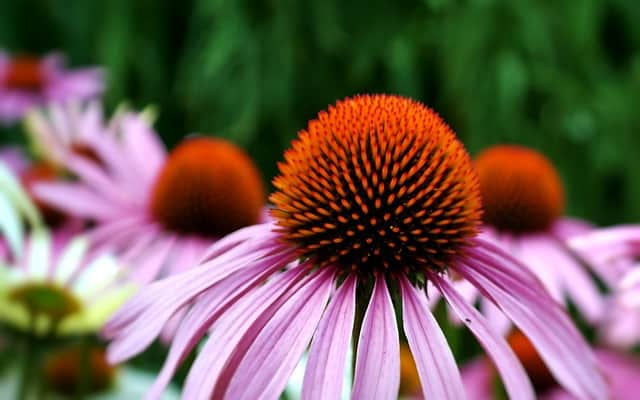
The Coneflower (Echinacea) is a resilient perennial that thrives in colder temperatures and adds a unique architectural element to your fall pots. Famous for their daisy-like blooms and prominent central cones, these flowers radiate a sense of joy and vibrancy. Coneflowers come in a multitude of colors, including purple, pink, yellow, and even white varieties, making them a delightful choice for mixed pots this autumn.
When incorporating coneflowers into containers, consider selecting dwarf varieties, such as ‘PowWow Wild Berry’ or ‘Butterfly Kisses,’ which maintain a compact stature usually ranging from 12 to 18 inches. These plants prefer full sun and well-drained soil, often thriving in less fertile conditions, so a simple potting mix works well. To promote healthy growth and prolonged blooming, add a slow-release fertilizer that will nourish the plants throughout the fall.
Coneflowers are also beneficial for attracting pollinators, including bees and butterflies, making your pots not only stunning but also lively habitats for wildlife. After the flowers have faded, their seed heads can become attractive winter features, offering sustenance for birds and maintaining visual interest in your outdoor space.
Coral Bells

Coral Bells (Heuchera) are enchanting perennial plants celebrated for their mesmerizing foliage, which can range from deep burgundy to bright lime green. Their leaves provide a stunning visual canvas that adds depth to your fall pots as the natural landscape transforms. Easy to care for, Coral Bells are quite versatile; they flourish in both sunny and partially shaded spots, making them perfect for various container arrangements.
When choosing Coral Bells for your pots, select varieties such as ‘Palace Purple’ or ‘Caramel,’ known for their striking color contrasts and lower growth habit, typically reaching heights of 12 to 24 inches. Their airy flower spikes, adorned with small, bell-shaped blooms, emerge in late summer and can last into early fall, heightening the seasonal aesthetic.
To enhance the beauty of your containers, consider mixing Coral Bells with complementary fall flowers like pansies or ornamental grasses. Their low-maintenance nature makes them ideal for busy gardeners looking to enjoy a stunning display without extensive upkeep. Additionally, they are drought-tolerant once established, requiring only regular watering to keep their vibrant leaves crisp and healthy. By incorporating Coral Bells into your fall pots, you’ll enjoy a delightful blend of color and texture that adds sophistication to your autumn décor.
Cosmos
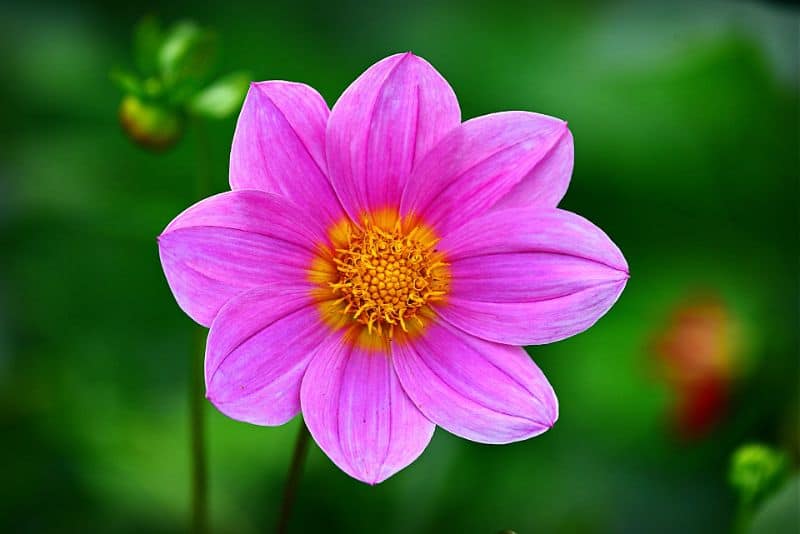
For those seeking a lively burst of color during the fall, Cosmos are an excellent choice. These cheerful annuals thrive in containers, producing vibrant flowers in a range of colors, from pristine white to bold magenta and sunny yellow. Cosmos are known for their upright, bushy habit, providing a playful contrast against the more traditional autumn foliage.
Benefits of planting Cosmos in pots include their ability to withstand cooler temperatures and tolerate light frosts, enabling them to bloom well into fall. Varieties such as ‘Cosmic Orange’ or ‘Sonata’ display a compact growth pattern, making them suitable for container gardening and ensuring that their colorful blooms shine brightly without overwhelming smaller pots.
Cosmos thrive in full sun and are low-maintenance, requiring well-drained soil and moderate watering, which makes them perfect for gardeners of all experience levels. Pairing them with cooler-weather plants, like purple kale or even decorative gourds, creates eye-catching arrangements that not only pop with color but evoke the playful spirit of autumn. Cosmos’ ability to sway gently in the breeze adds an element of movement, enhancing the inviting atmosphere of your outdoor space.
Crossandra
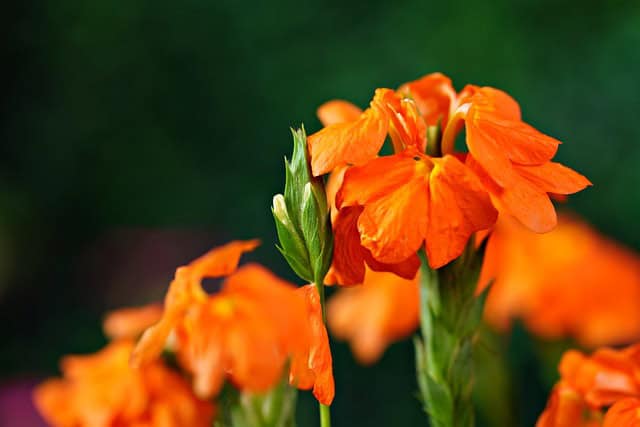
Crossandra is a striking tropical plant that brings a touch of the exotic to your fall pots. Known for its clusters of tubular flowers that bloom in shades of orange, apricot, and soft yellow, Crossandra adds warmth and a delightful pop of color as the weather cools down. Although typically grown as an indoor plant in cooler regions, it can still be incorporated into your fall container displays as a seasonal highlight.
When planting Crossandra in pots, opt for well-drained, moisture-retentive soil, and provide ample sunlight, as this plant prefers locations that receive bright, indirect light. It thrives in temperatures above 60°F, which is ideal for fall climates, but may need protection from frost. Positioning pots in a sheltered area during chilly nights will extend the plant’s lifecycle and allow you to enjoy its stunning blooms.
Crossandra also pairs beautifully with more traditional fall flowers such as chrysanthemum or marigold, adding an unexpected flair that can make your pots stand out. While Crossandra requires consistent moisture, it’s crucial to ensure excellent drainage in the pots to prevent root rot. By incorporating this unique tropical plant into your fall arrangements, you create a distinctive look that brightens up your outdoor space while celebrating the seasonal shift.
Incorporating Coral Bells, Cosmos, and Crossandra into your collection of fall plants for pots not only elevates your outdoor aesthetic but also enriches the sensory experience of your garden. With their diverse colors, textures, and growth habits, these plants make it easy to create stunning arrangements that embody the enchanting spirit of autumn while showcasing your personal gardening style.
Croton
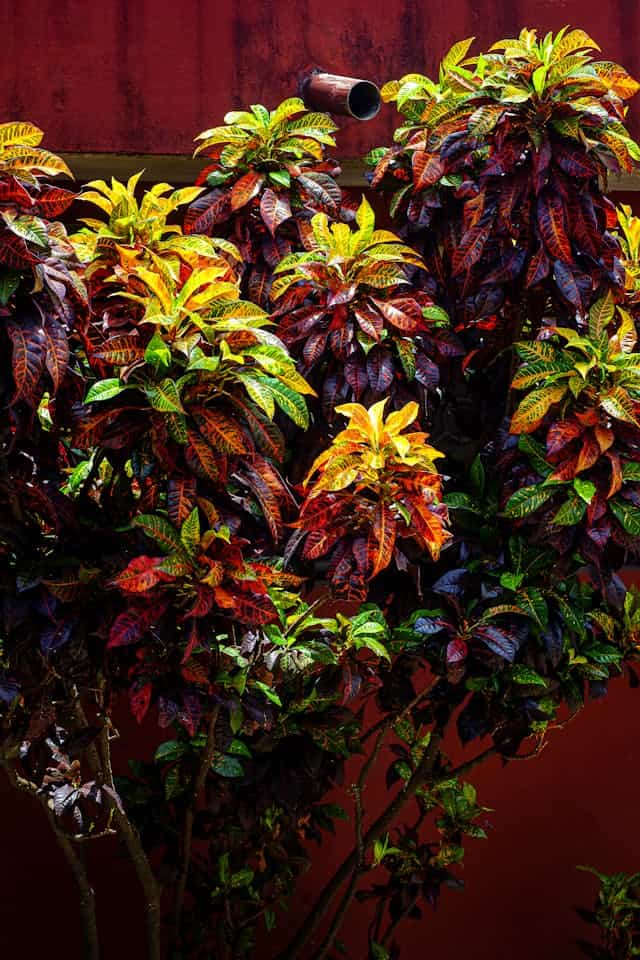
Croton (Codiaeum variegatum) is a fantastic choice for adding exotic flair to your fall pot displays. Known for its strikingly colorful foliage, Croton showcases an array of hues, including deep greens, vibrant yellows, reds, and oranges. This tropical plant brings a cheerful pop of color that harmonizes beautifully with the fall palette, making it an alluring focal point in any arrangement.
When choosing Croton for your pots, look for varieties such as ‘Petra’ or ‘Gold Star,’ which boast bold leaf patterns and robust growth. While Croton is typically used as an indoor houseplant in regions with colder winters, it can thrive outdoors in warmer climates through the fall. Ideally, it likes full sun but can tolerate partial shade, particularly in hotter climates.
For optimal care, ensure your pots are well-draining to prevent waterlogging, and provide consistent moisture without letting the soil dry out completely. Pairing Croton with seasonal flowers such as pansies or ornamental cabbage can create a striking contrast, enhancing an already vibrant display. This plant also offers the advantage of being relatively low-maintenance, requiring only occasional pruning to maintain its shape and encourage fuller growth. Adding Croton to your fall pot collection not only brings a touch of the tropics to your garden but also adds vibrant colors that can withstand the cooler months ahead.
Dahlia (Dahlia spp.)
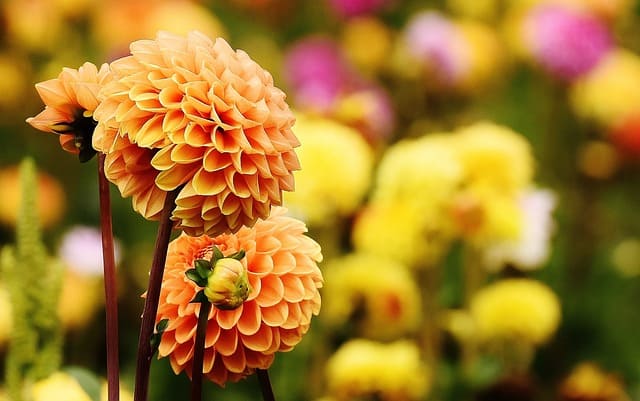
Dahlias are a fall favorite among gardeners, prized for their stunning blooms that can range in shape, size, and color, making them perfect for large, eye-catching pot arrangements. Known for their lush, vibrant flowers, dahlias can come in hues of deep purples, fiery reds, bright yellows, and soft pastels, providing an unrivaled palette for your outdoor display.
When selecting dahlias for pots, consider medium to dwarf varieties like ‘Bishop of London’ or ‘Gallery Art Deco.’ These compact plants typically reach heights of 12 to 24 inches and are well-suited for container gardening. Dahlia tubers can be planted in spring or early summer, but they often thrive into the fall until the first frost hits, extending their beauty into the cooler months.
Dahlias prefer full sun and fertile, well-drained soil to encourage optimal growth and impressive blooms. To enhance their display, use a potting mix enriched with compost or slow-release fertilizer to provide the necessary nutrients. To encourage prolonged blooming, regular deadheading is essential; this technique involves removing faded flowers, which helps the plant produce new blooms. Combining dahlias with complementary plants, such as ornamental grasses or fall-hued asters, can create a visually stunning arrangement, and their long-lasting blooms make them a worthwhile addition to any fall pot collection.
Dianthus (Dianthus spp.)

Dianthus, commonly known as pinks or carnations, are versatile perennials that add a touch of charm and elegance to any fall container. Valued for their fragrant blooms and attractive foliage, Dianthus produces clusters of delicate flowers in shades of pink, white, and red, making it a delightful contrast against the earthy tones of fall.
When selecting Dianthus for your pots, varieties like ‘Paint the Town’ or ‘Firewitch’ are excellent choices, as they tend to remain compact and are highly resilient in cooler temperatures. These plants thrive in full sun and prefer well-drained soil, making them perfect for your autumn arrangements, where drainage is key to preventing rot.
Dianthus also has the added benefit of being drought-resistant once established, requiring less frequent watering than many other fall flowers. To create an engaging display, consider mixing them with other plants, such as the vibrant foliage of croton or the bold blooms of dahlias, as their structured flowers provide a lovely contrast to the more exuberant shapes.
Furthermore, Dianthus can bloom well into fall, providing a delicate charm even as temperatures drop. With their captivating fragrance and delightful colors, incorporating Dianthus into your fall pots not only enhances your garden’s beauty but also fills your outdoor space with pleasant aromas that make the season even more enjoyable.
Dusty Miller

Dusty Miller (Senecio cineraria) is an excellent choice for incorporating silvery foliage into your fall garden. Known for its striking, gray-green leaves covered in soft, woolly hairs, this perennial plant creates a stunning contrast alongside brighter blooms. The soft, silvery color of Dusty Miller can serve as a beautiful backdrop for the deep colors of traditional autumn flowers, enhancing the overall visual appeal of your arrangements.
Dusty Miller thrives in full sun, making it a perfect candidate for fall pots that will bask in golden sunlight during crisp autumn days. This hardy plant can tolerate a range of soil conditions, though it prefers well-drained soils to avoid root rot. When using Dusty Miller in your pots, consider planting it alongside flowering plants such as chrysanthemums or ornamental peppers to achieve a balanced, seasonal arrangement.
One of the many benefits of Dusty Miller is its durability in cooler temperatures. It often continues to provide visual interest long into the fall and even into early winter, depending on the climate. With minimal maintenance required—just an occasional trimming to promote bushy growth and remove any dead foliage—this plant is ideal for gardeners wanting to add an effortless charm to their fall displays.
Dwarf Japanese Maple

Adding a Dwarf Japanese Maple (Acer palmatum) to your fall pots infuses elegance and sophistication into your outdoor arrangements. These trees are renowned for their finely dissected leaves, which vary in color from deep green to vibrant red, orange, and purple in the fall, creating a breathtaking spectacle as autumn sets in. Given their compact size, many dwarf varieties, such as ‘Shaina’ or ‘Green Carpet,’ are perfect for container gardening, allowing them to become stunning focal points on patios, porches, or balconies.
Dwarf Japanese Maples prefer partial shade to filtered sunlight, which encourages healthy growth while preventing leaf scorch. When selecting a container, ensure it is large enough to accommodate the root system, as these trees can grow to about 3 to 6 feet tall, depending on the variety. Utilizing high-quality potting soil that provides adequate drainage is crucial, as Japanese Maples are sensitive to waterlogged conditions.
The versatility of Dwarf Japanese Maples makes them ideal companions in pots with other fall favorites. Pairing them with lower-growing plants like ornamental grasses or colorful pansies allows for layered dimensions and varied textures. Additionally, their stunning fall colors are sure to provide a commanding presence in your outdoor space, creating a striking arrangement that captures the essence of the season.
Echinacea
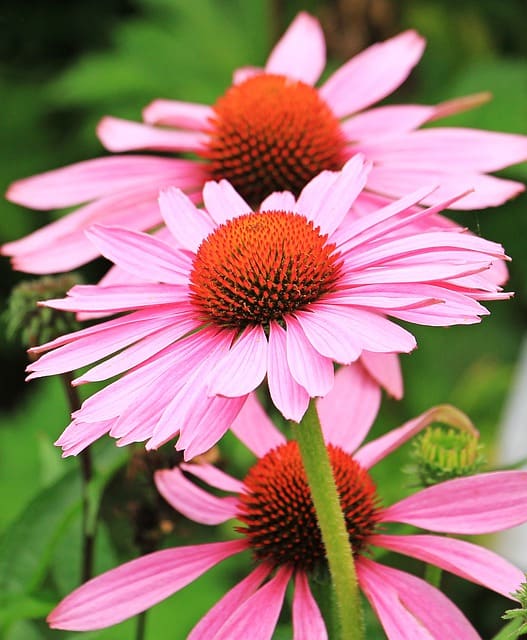
Echinacea, commonly known as coneflower, adds not only visual beauty but also a sense of vitality to your fall pots. Recognized for its daisy-like blooms and prominent central cone, Echinacea comes in various colors, including classic purple, white, pink, and even orange varieties. This perennial plant offers a delightful pop of color that persists into fall, making it an ideal choice for your containers.
When cultivating Echinacea in pots, opt for compact varieties such as ‘Pixie Meadowbright’ or ‘Cheyenne Spirit,’ which are well-suited for container gardening. Echinacea thrives in full sun, requiring at least six hours of direct light each day, and it prefers well-drained soil, allowing its roots to remain healthy and prevent rot. This plant is also known for its drought-resilient qualities, making it an excellent choice for those looking to establish low-maintenance displays.
In addition to its ornamental properties, Echinacea attracts pollinators such as bees and butterflies, which enhances your garden’s liveliness during the fall months. For a more dynamic look, pair Echinacea with foliage plants like Dusty Miller or the rich colors of Dwarf Japanese Maples. Together, these botanical partners create a captivating contrast, blending textures and colors that embody the essence of the autumn season.
Globe Amaranth
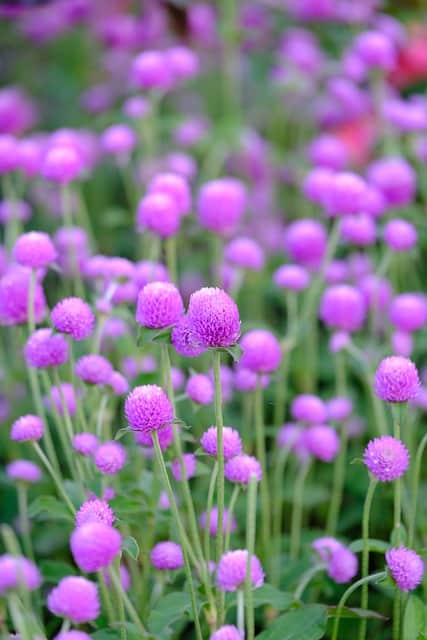
Globe Amaranth (Gomphrena globosa) is a charming annual known for its globe-shaped, brightly colored flower heads that lend a playful touch to fall pots. These resilient plants come in a variety of shades, including vibrant purples, pinks, reds, and whites, creating an eye-catching display as they bloom profusely from late summer into fall. Their cheerful, rounded flowers add a whimsical component to your seasonal arrangements.
In addition to their ornamental appeal, Globe Amaranth is particularly hardy and tolerant of both heat and drought, making it an excellent choice for fall container gardening. Select compact varieties, such as ‘Strawberry Fields’ or ‘QIS Purple,’ which are well-suited for pots and offer a petite growth habit ideal for smaller spaces.
Globe Amaranth thrives best in full sun, requiring at least six hours of sunlight a day to achieve robust growth and vibrancy. The flowers are not only beautiful but also long-lasting; they can be dried and used in arrangements, extending their decorative value. For stunning combinations, consider pairing Globe Amaranth with contrasting foliage plants like Dusty Miller or the deep reds of Dwarf Japanese Maple. This will enhance the dynamic colors in your pots while celebrating the brilliance of autumn.
Golden Creeping Jenny
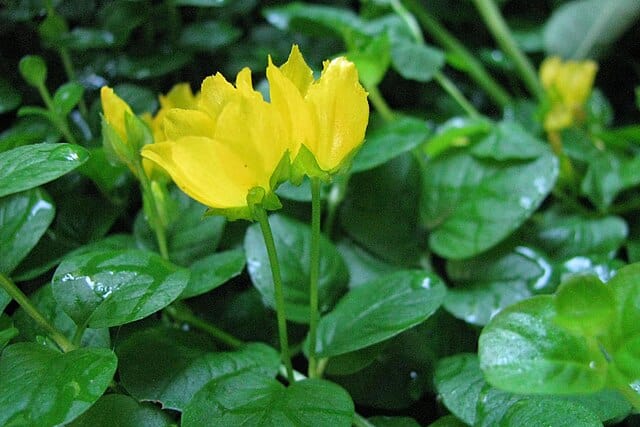
Golden Creeping Jenny (Lysimachia nummularia ‘Aurea’) is a beloved perennial known for its bright golden-yellow foliage that shines brilliantly in fall. This low-growing ground cover plant is an excellent choice for container arrangements, spilling over the edges of pots to create a lush cascading effect. Its vibrant leaves transition more slowly into cooler weather, providing a continuous splash of color as other plants begin to lose their vibrancy.
Ideal for both sunny and partially shaded areas, Golden Creeping Jenny thrives in well-drained soil and is relatively low on maintenance. This versatility makes it a suitable companion for a variety of other fall plants in pots, whether they prefer full sun or enjoy a bit of shade.
Because of its trailing nature, Golden Creeping Jenny pairs beautifully with upright plants such as Echinacea or Dahlias, creating a visually appealing contrast between height and cascading foliage. In addition to its ornamental appeal, this plant is also quite hardy and can tolerate a variety of soil conditions, making it an easy addition to your fall pot ensemble. With its cheerful golden hue, it brightens up any garden space, embodying the warmth of fall while providing a delightful contrast to deeper autumn shades.
Goldenrod
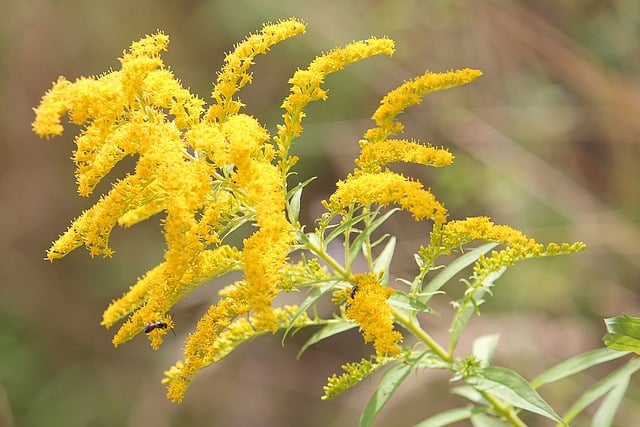
Goldenrod (Solidago spp.) is a truly spectacular choice for those looking to capture the warmth and richness of fall in their pots. Known for its tall, plume-like clusters of bright yellow flowers, Goldenrod adds a vibrant pop of color to any arrangement during the autumn months. Traditionally celebrated for its beauty, this perennial also plays an important role in supporting pollinators, drawing in bees and butterflies with its bright blooms.
When incorporating Goldenrod into your fall pots, consider selecting compact varieties such as ‘Golden Fleece’ or ‘Little Lemon’ which maintain a manageable height and are well-suited for container gardening. Goldenrod generally prefers well-drained soil and a sunny location, ensuring it achieves optimal growth with a burst of color during the cooler months of the year.
Goldenrod’s tall flower spikes can create a dramatic backdrop when planted alongside lower-growing plants. Pair it with the golden tones of Creeping Jenny or the earthy colors of Dahlia to form stunning visual layers in your pot arrangements. Additionally, it is a relatively low-maintenance plant, requiring minimal care once established, which makes it a wonderful option for both novice and experienced gardeners.
Helenium

Helenium, often referred to as Sneezeweed, is a fall-blooming perennial that brings a burst of warm colors to your container garden. Exhibiting fiery shades of yellow, orange, and red, Helenium flowers are reminiscent of autumnal foliage and provide a lively contrast against the cooler tones of the season. The flower heads are typically daisy-like, with a central cone and petal-like rays that create a cheerful exuberance, making them a focal point in any pot arrangement.
Helenium prefers full sun to thrive, requiring well-drained soil to prevent root rot. When selecting Helenium for pots, consider varieties like ‘Moerheim Beauty’ or ‘Short ‘n Sassy,’ which have a more compact growth habit, making them easier to manage in container settings. These varieties not only survive but flourish during cooler temperatures, offering continuous blooms from late summer into the heart of fall.
To maximize the visual impact of Helenium in your pots, consider pairing them with other late-blooming plants such as Asters or ornamental grasses, which complement their rounded forms and vibrant colors. Beyond their appeal, Helenium also attracts pollinators, further enriching the ecosystem of your garden as it provides vital resources to bees and butterflies in their active fall season.
Hydrangea (Hydrangea spp.)
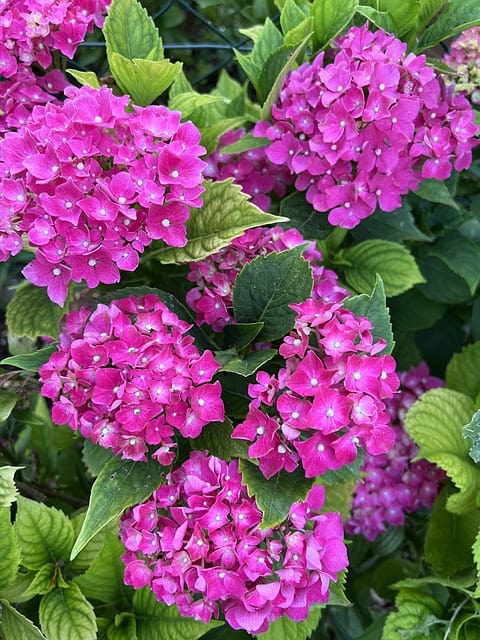
Hydrangeas are a classic choice for any container garden, offering large, lush blooms that can elevate your fall pot displays. Known for their ability to change colors based on soil pH, these magnificent plants can showcase hues ranging from soft pinks and blues to deep purples and whites. This versatility allows for creative combinations that can suit various aesthetic preferences, making Hydrangeas an ideal addition to your fall arrangements.
Certain varieties, like ‘Little Lime’ or ‘PeeGee,’ are particularly well-suited for container gardening due to their compact size. These hydrangeas can be kept in pots, allowing them to flourish and reach a manageable height, enhancing your outdoor spaces. Hydrangeas prefer a spot with morning sun and afternoon shade to prevent wilting, making them somewhat flexible in terms of light conditions.
To provide proper care, make sure to use well-drained, enriched potting soil and water regularly, especially during dry spells. The striking ball-like clusters of blooms can be paired stylishly with other seasonal plants, such as ornamental kale or fall pansies, which provide a wonderful texture contrast and continue the seasonal theme. As fall progresses, the changing colors of hydrangea blooms deepen, adding to the evolving beauty of your pots, ensuring they stand out in your outdoor decor long into the fall.
Impatiens
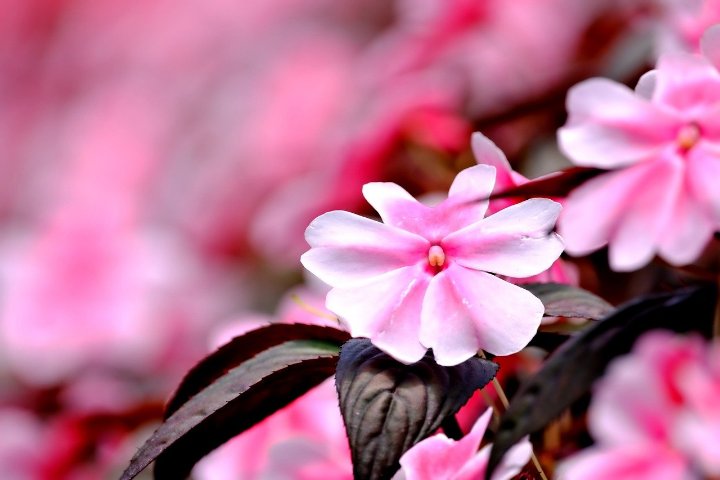
Impatiens are often synonymous with vibrant color, making them a fabulous option for fall container gardens. Known for their lush, sweeping blooms that flourish in various shades—including pink, white, red, lavender, and even bi-colored—their prolific flowering habit can bring radiant color to pots as the landscape transitions. While typically classified as warm-weather plants, certain varieties can endure the cooler days of early fall if properly cared for.
Impatiens thrive in well-drained soil and prefer partial to full shade, which makes them a wonderful option for shaded patios or areas under trees where many other autumn flowers might struggle. If you want a longer-lasting display, try using New Guinea Impatiens, which tend to be more sun-tolerant and resilient against cooler temperatures.
For an eye-catching arrangement, consider combining Impatiens with other shade-loving plants like ferns or Heucheras, which provide contrasting foliage and help create an engaging depth in your container. Their vibrant flower colors can brighten even the gloomiest autumn days, creating a warm and inviting atmosphere on your porch or patio as the season progresses.
Japanese Anemone (Eriocapitella x hybrida)
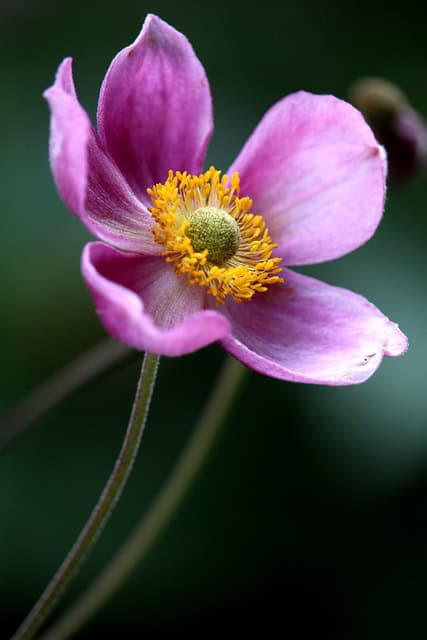
Japanese Anemone, commonly known as windflower, is a delightful addition to any fall container garden, renowned for its graceful blooms and elegant foliage. With their delicate, cup-shaped flowers that appear in shades of white and soft pink, these perennials create a sophisticated touch to your pots as summer transitions into autumn. Blooming from late summer through fall, Japanese Anemones provide a lovely extension of color when many other plants have begun to fade.
These plants prefer well-drained soil and a location that receives partial shade, making them an excellent choice for pots situated in dappled sunlight. They are relatively low-maintenance but do appreciate regular watering during dry spells to maintain healthy growth and vibrant blooms. When paired with taller grasses or contrasting foliage plants, Japanese Anemones can create a stunning effect that adds height and a sense of movement to your arrangements.
Incorporating Japanese Anemones into your fall pots not only enhances their aesthetic appeal but also contributes to your garden’s biodiversity by attracting pollinators like bees and butterflies. Their graceful silhouette and soft color palette make them a perfect fit for achieving a romantic autumn vibe, especially when planted alongside foliage plants that can frame their delicate flowers beautifully.
Lamium
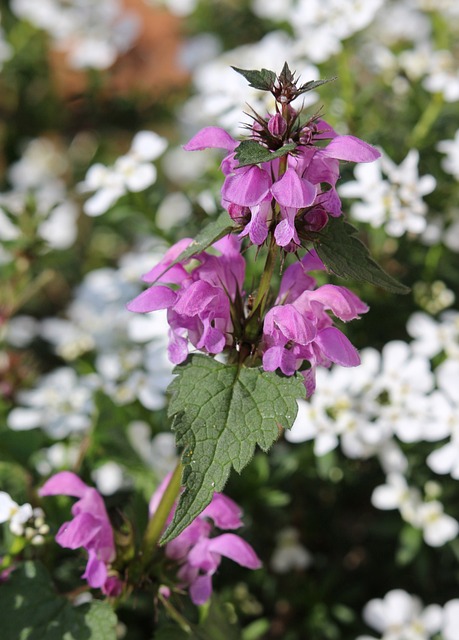
Lamium, or deadnettle, offers an attractive and versatile option for fall container gardening. This ground-covering perennial is prized for its vibrant, heart-shaped leaves, which often feature striking silver or variegated patterns, alongside charming clusters of pink or white flowers. As the days shorten, Lamium’s foliage tends to become even more pronounced, adding significant texture and contrast to your pots.
Lamium thrives in partial to full shade, making it an ideal choice for areas that may not receive much direct sunlight during the fall months. This plant is also very forgiving, able to tolerate various soil types, and is particularly drought-resistant once established. For pot arrangements, opt for varieties such as ‘Pink Chablis’ or ‘Beacon Silver,’ which will offer colorful blooms and lush foliage throughout the season.
The trailing nature of Lamium makes it a wonderful partner for taller plants. By planting Lamium around the edges of your containers, you can create a cascading effect that enhances the visual depth of each arrangement. Consider pairing it with durable companion plants such as Ferns or Japanese Anemones to create a layered look that captures attention and brings out the intricate textures of your garden pots.
Lantana
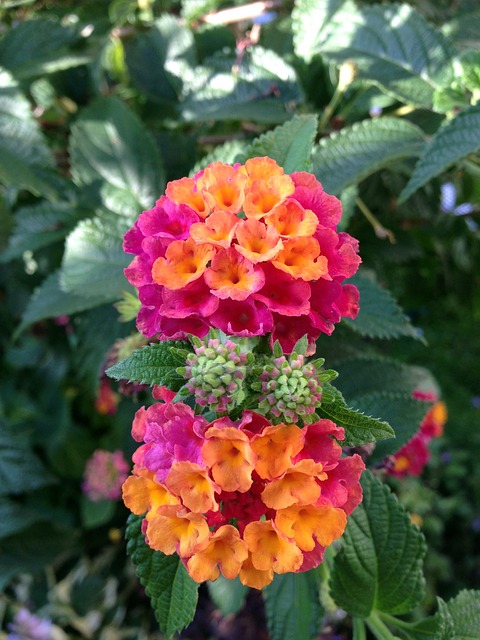
Lantana is a vibrant, perennial favorite that adds a burst of color to any fall container arrangement, known for its clusters of tiny, tubular flowers that bloom in rich shades of yellow, orange, purple, pink, and white. These resilient plants thrive in warmer climates and can withstand cooler autumn temperatures, making them a great candidate for container gardening during transitional seasons. Their cheerful appearance not only ignites interest but keeps your pots looking lively as the weather cools.
Lantanas prefer full sun and well-drained soil, which makes them easy to care for while providing their signature profusion of blooms. As a drought-tolerant plant, they require less frequent watering compared to other varieties—making them an excellent option for more carefree gardeners. Not only do they brighten up your fall arrangements, but Lantana also attracts butterflies and hummingbirds, enhancing the liveliness of your garden space.
For striking combinations, consider using Lantana alongside trailing plants like Lamium or colorful foliage plants like ornamental sweet potatoes, adding layers of color and texture to your pots. The contrast between the upright, vibrant clusters of Lantana flowers and the softer, sprawling greens of Lamium creates a compelling visual dynamic, ensuring that your container displays stand out throughout the season.
Marigold
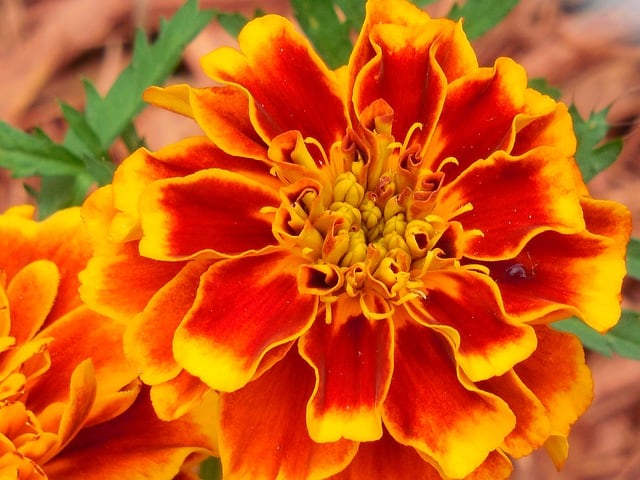
Marigolds are a quintessential choice for fall pots, celebrated for their bright and cheerful blooms, which range from deep oranges and fiery yellows to rich reds. These annuals, belonging to the Tagetes genus, are not only visually stunning but are known for their resilience and ability to bloom continuously, even as temperatures dip. They make an ideal addition to your autumn containers, providing color and vibrancy that cherishes the lingering warmth of the season.
Beyond their aesthetic appeal, Marigolds are also valued for their benefits to garden health. They naturally repel certain pests, such as nematodes and aphids, making them a great companion plant to cultivate alongside other fall blooms. They’re incredibly easy to grow, preferring well-drained soil and full sun. Just a little deadheading encourages more blooms, allowing you to enjoy their lovely, rich colors throughout fall.
In container arrangements, consider combining Marigolds with complementary plants like ornamental cabbage or kale, which adds texture and depth while creating a striking visual contrast. Alternatively, pairing them with soft, trailing varieties such as Dichondra can soften the overall appearance of the arrangement, delivering a delightful garden aesthetic that captures the essence of autumn.
Mexican Bush Sage
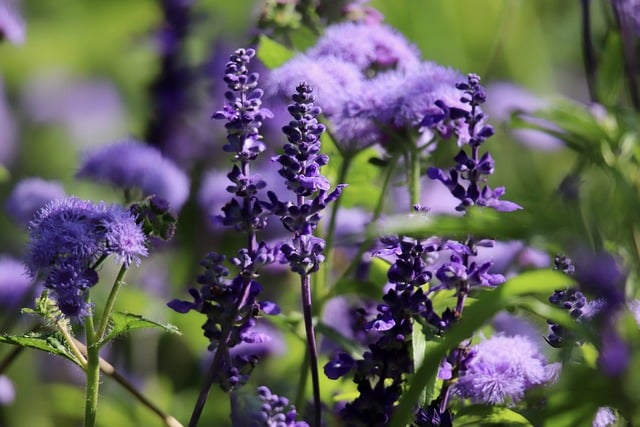
Mexican Bush Sage (Salvia leucantha) brings a touch of exotic flair to fall pots, with its striking spikes of velvety purple flowers that bloom from late summer into the fall. This perennial is not only famed for its vibrant color but also for its unique texture, with silver-green leaves that provide a lovely backdrop for its brilliant blooms. As the weather cools, these captivating flowers attract butterflies and other pollinators, enhancing the biodiversity of your garden.
Mexican Bush Sage thrives in well-drained soil and prefers a sunny location, making it suitable for pots positioned in bright spots. It is also quite drought-tolerant once established, requiring minimal upkeep and making it a perfect choice for gardeners seeking low-maintenance options as the season changes.
Incorporating this salvia into your fall pot displays allows for an incredible contrast when paired with warmer colors found in other late-blooming plants. Consider planting it alongside the golden tones of Helenium or the rich colors of Asters to create a bold and captivating presentation. Mexican Bush Sage seamlessly integrates into a diverse range of arrangements, providing both height and texture to create a visually dynamic display.
Million Bells
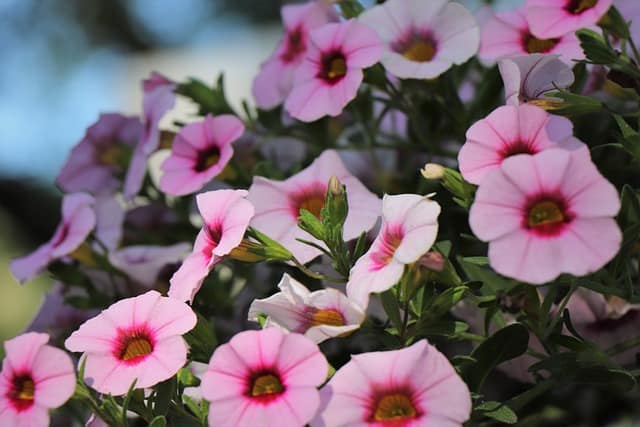
Million Bells (Calibrachoa), known for its abundant, trumpet-shaped flowers, is an outstanding choice for fall containers. These charming annuals flower profusely in a multitude of colors, including bright yellows, vibrant reds, soft pinks, and deep purples, often featuring a bicolor effect that adds depth to any arrangement. Their trailing habit makes them an ideal option for hanging baskets or pots, where they can spill over the edges, creating a cascade of color that brightens up even the cloudiest fall days.
One of the most appealing aspects of Million Bells is their ability to thrive in well-drained soil and sunny locations, and they require minimal maintenance, delighting gardeners with continuous bloom throughout the season. Regular watering and occasional deadheading will help maintain their vibrant appearance, ensuring your arrangements look fresh and lively.
Combining Million Bells with upright plants like Salvia or Lantana enhances the visual interest of your pots while creating a lovely interplay of shapes and colors. Using them as trailing elements can soften the pot’s edges, fulfilling the dual role of color and movement. As the flowers remain abundant, they create a joyful, inviting atmosphere that encapsulates the spirit of fall.
Ornamental Cabbage and Kale
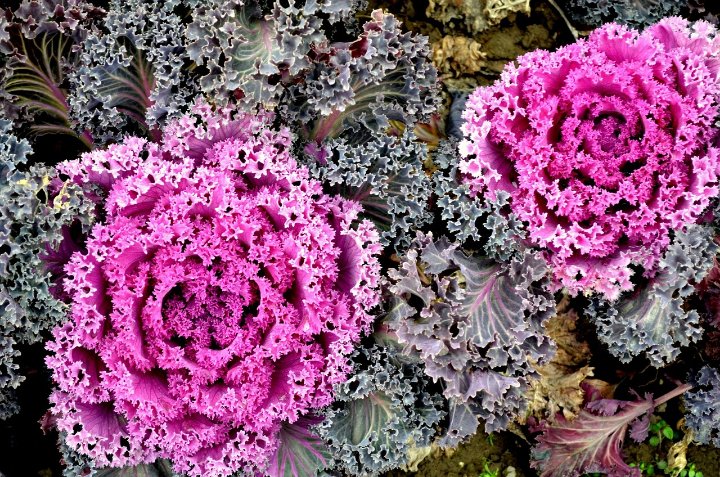
Ornamental Cabbage and Kale add a dramatic touch to fall pots with their lush, rosette-shaped foliage that often features striking colors and patterns. These cool-season plants are known for their ability to withstand frost, making them ideal for late-season displays. Unlike their edible counterparts, Ornamental Cabbage and Kale are specifically bred for their aesthetic qualities, presenting a dazzling array of colors ranging from deep purples and pinks to vibrant greens with white or cream edges.
Planting these leafy beauties in pots not only adds a pop of intrigue but also provides substantial structure to your arrangements. They thrive in well-drained soil and prefer full sun to partial shade. Regular watering is essential during dry spells to maintain their vibrant colors and crisp leaves. When combined with seasonal favorites like Mums or hardy pansies, Ornamental Cabbage and Kale can create stunning contrasts that highlight their textual beauty while ushering in the warmth of fall.
Additionally, these plants can withstand cooler temperatures, allowing you to enjoy your pots well into late fall and even early winter. Their resilience also makes them a popular choice for festive arrangements, especially when adorned with twinkling fairy lights or seasonal decorations for a truly enchanting fall display.
Ornamental Millet
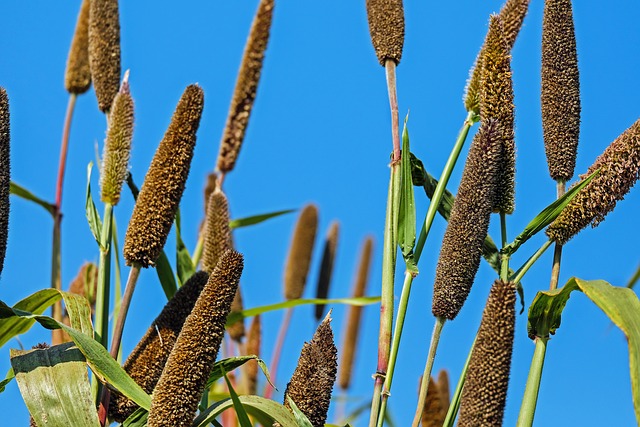
Ornamental Millet (Pennisetum glaucum) is a captivating choice for containers, showcasing unique, spiky flower heads and colorful foliage that provide a striking addition to any autumn pot arrangement. Known for its rich shades of burgundy, purple, and green, this grass-like plant can grow quite tall, adding height and dimension to your displays. The plant’s feathery flower spikes emerge from the lush foliage in late summer and linger throughout fall, maintaining visual interest as they change appearance in the cooler weather.
The versatility of Ornamental Millet allows it to thrive in a variety of soil types, though it prefers well-drained soil and full sun. This drought-tolerant plant is relatively low-maintenance, making it an attractive choice for those looking to create beautiful pot arrangements with minimal fuss. By pairing Ornamental Millet with plants that showcase contrasting colors and textures, such as soft Silver Mound or the vibrant blooms of Marigold, you can create dynamic visual layers that pull the eye through your displays.
Moreover, the airy flower heads of Millet can stand out beautifully against the backdrop of other fall decorations, making them a wonderful addition to any outdoor space. Their distinctive look enables them to serve as focal points or complementary elements in a variety of container combinations, ensuring your fall plants for pots capture attention throughout the season.
Ornamental Peppers

Ornamental Peppers (Capsicum annuum) introduce a dash of playful color to your fall container gardens with their vibrant, tiny fruits that range in color from bright yellow and orange to deep purple and red. These eye-catching plants are both decorative and functional; their colorful fruits not only serve as a feast for the eyes but also add a touch of whimsy to your arrangements. While they are technically edible, the ornamental varieties are often more appreciated for their aesthetic qualities rather than taste.
Ornamental Peppers are hardy plants that thrive in full sun, making them ideal candidates for vibrant container displays. They require well-drained soil and benefit from regular watering and fertilization to promote healthy growth and prolific fruiting throughout the fall season. Combining these peppers with rich foliage plants, such as the dramatic leaves of Ornamental Kale or the trailing Lamium, creates an exciting contrast that draws attention to your arrangements while celebrating the spirit of autumn.
As the bright colors of Ornamental Peppers deepen in hues, they provide a festive atmosphere, perfect for enhancing autumn markets or Thanksgiving displays. Their striking profiles can even serve as a playful hint of Halloween as the season progresses, making them a delightful addition to any fall pot collection.
Oxalis or Shamrock (Oxalis regnellii)
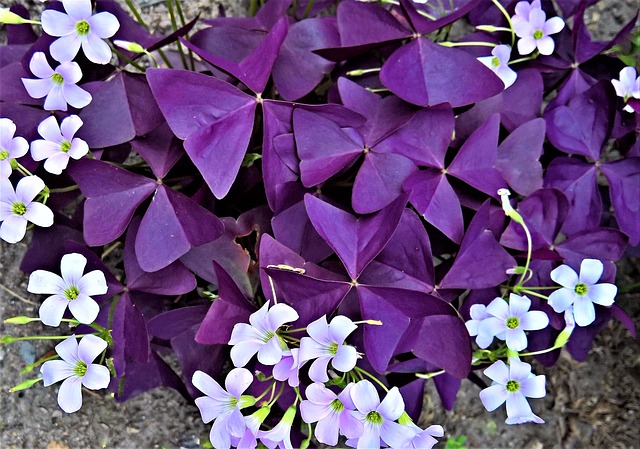
Oxalis, affectionately known as Shamrock, is a delightful option for fall pots, especially celebrated for its whimsical leaf shapes that resemble little clovers. This perennial is often recognized for its tri-leaf structure and comes in various colors, including vibrant greens with hints of purple, making it a stunning focal point in any container. In the fall, Oxalis produces delicate, cup-shaped flowers, primarily in shades of white or pale pink, adding elegance to your arrangements.
This adaptable plant is typically easy to grow and thrives in well-drained soil with bright, indirect light. While it can tolerate some direct sunlight, keeping it in a location with dappled light can help prevent leaf scorch and promote lush growth. Regular watering is essential, but it’s crucial not to overwater, as excessive moisture can lead to root rot.
Planting Oxalis alongside other fall favorites such as Ornamental Cabbage or flowering Kales can provide an interesting contrast in form and texture—offering a sense of the whimsical alongside the structured. This combination cultivates a rich visual dynamic, making your pots come alive with color and character during the autumn months.
Pansies

Pansies are a staple in fall gardening, revered for their cheerful faces and remarkable ability to flourish in cooler temperatures. With a wide array of colors, including vibrant purples, yellows, blues, and more, these annuals can create a playful and colorful backdrop in any pot arrangement. Pansies are known for their hardiness, often bouncing back even after light frosts, making them perfect for late-season displays.
Ideal for container gardening, Pansies thrive in well-drained soil and prefer full sun to partial shade. For optimal growth, ensure they are watered regularly, as their roots enjoy consistent moisture. These lovely flowers also benefit from light fertilization, especially when planted in nutrient-poor soil, to support their continued blooming throughout the fall.
For eye-catching arrangements, consider combining Pansies with contrasting textures, such as the striking foliage of Ornamental Cabbage or trailing plants like Ivy. Layering Pansies with these different elements creates an engaging visual experience, further enlivened by their charming flower patterns. Moreover, Pansies can also enhance the early spring landscape; when planted in the fall, they often act as a precursor to spring blooms, making them a versatile choice for extended enjoyment.
Petunia
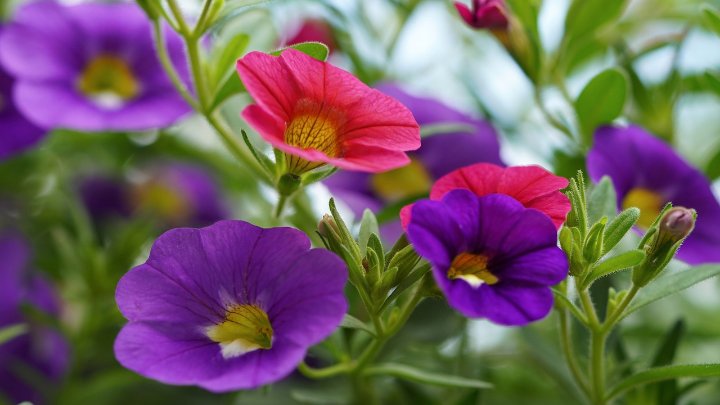
Petunias are yet another vibrant addition to fall pot arrangements, known for their prolific blooms and wide range of colors and patterns. From solid hues to intricate stripes and speckles, Petunias can instantly brighten any outdoor area. Their fragrant flowers offer not only visual appeal but also a delightful scent that can enhance your garden experience as you enjoy the crisp autumn air.
These annuals prefer well-drained soil and thrive in full sun, making them an excellent choice for warm, sunny locations. Petunias are relatively low-maintenance but do require regular watering, especially in pots, to keep their roots hydrated. Deadheading spent blooms will encourage further flowering, allowing you to enjoy the vibrant nature of Petunias throughout the fall.
Incorporating Petunias into your fall pots can create stunning combinations with other blooming plants like Pansies or hardy ornamental grasses. Their trailing varieties make for excellent filler plants that soften the edges of pots while providing lushness. Combining Petunias with contrasting foliage plants, such as trailing Lobelia or spiky grasses like Blue Fescue, can yield striking arrangements that make your fall containers truly stand out.
Purple Fountain Grass
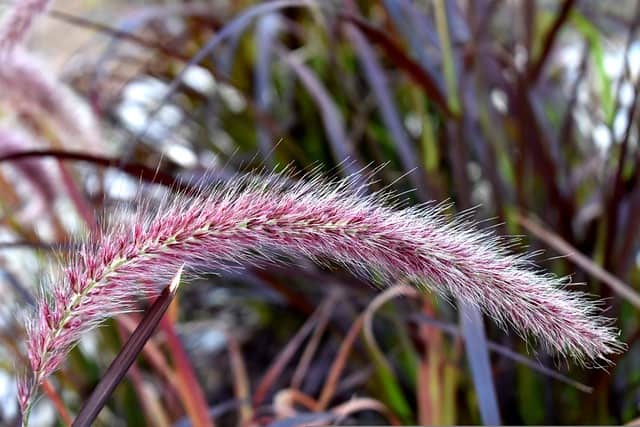
Purple Fountain Grass (Pennisetum setaceum ‘Rubrum’) is a popular ornamental grass renowned for its dramatic arching form and feathery plumes. As the name suggests, this grass boasts striking purple-hued foliage that intensifies in color throughout the fall months, providing a stunning contrast against the rich tones of autumn leaves. The elegant, arching habit of Purple Fountain Grass adds graceful movement to pots, making it a showstopper in any outdoor setting.
This perennial grass is adaptable, thriving in a variety of soil conditions, although well-drained soil in full sun showcases its beauty most effectively. One of the remarkable features of Purple Fountain Grass is its resilience; it tolerates drought conditions once established, requiring minimal maintenance. Its production of soft, tawny flower plumes not only enhances its charm but also provides a source of interest as they sway gently in the breeze.
In container gardens, pairing Purple Fountain Grass with vibrant fall flowers, such as pansies or marigolds, can create a striking color palette that captures the essence of autumn. The grass’s height allows it to serve as a backdrop or focal point, attracting attention while beautifully framing other seasonal blooms. As fall progresses, the graceful movement and color of Purple Fountain Grass can evoke a sense of warmth and tranquility, making it a valuable addition to any patio or garden space.
Red Rooster Grass
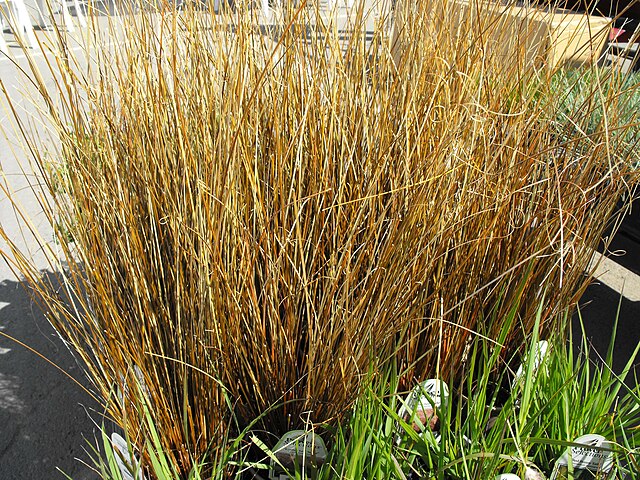
Red Rooster Grass (Pennisetum alopecuroides ‘Red Head’) is another visually impactful choice for fall pots, celebrated for its dramatic red-tipped plumes and rich green foliage. This perennial grass typically features upright growth, reaching heights that can enhance vertical interest in container arrangements. Its striking red flower spikes emerge as the temperature cools, providing a spectacular show that lasts throughout the fall and into winter.
Best suited for sunny locations with well-drained soil, Red Rooster Grass requires regular watering and benefits from a nutrient-rich potting mix to support its vibrant growth. Its tendency to bloom later in the season makes it an excellent companion for earlier or mid-season flowers, as its striking color can complement and elevate the overall aesthetic of your arrangements.
When combined with fall-blooming annuals or perennials, such as Asters or Ornamental Cabbage, Red Rooster Grass can create captivating contrasts in both height and color. Its robust form and vivid plumes bring texture and depth to container gardens, making it perfect for enhancing outdoor spaces with striking seasonal appeal. Red Rooster Grass can also continue to provide visual interest through winter, as its sturdy stems and seed heads catch frost or snow, offering a beautiful contrast against the winter landscape.
Salvia (Salvia yangii)

Salvia (Salvia yangii), commonly known for its vibrant clusters of tubular flowers, is an exceptional addition to fall pots. The rich purple or blue flowers attract pollinators such as bees and hummingbirds, transforming container gardens into lively ecosystems. These perennial plants boast a long blooming season, often blooming into late fall, making them a fantastic choice for gardeners looking to extend color in their outdoor spaces.
Salvia thrives in well-drained soil and requires full sun for optimal growth. This hardy plant is also drought-tolerant, which makes it ideally suited for containers where watering may be irregular. Regular deadheading of spent flowers encourages continued bloom and helps keep the plant looking fresh and vibrant throughout the fall season.
In terms of pairing, Salvia can beautifully complement the rich foliage of Ornamental Cabbage or the soft blooms of Petunias. Its upright growth habit provides a lovely contrast to trailing plants and low-growing varieties, creating layered arrangements that draw the eye. Furthermore, the aromatic leaves of Salvia can add an olfactory delight to your container garden, enriching the sensory experience as you enjoy the beauty of your fall plants for pots.
Sedum (Sedum, Hylotelephium spp.)
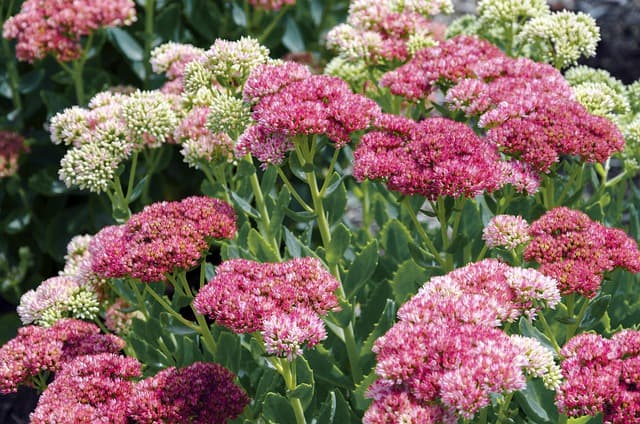
Sedum, often referred to as stonecrop, is an incredibly versatile succulent known for its fleshy leaves and beautiful star-shaped flowers. These hardy perennials are remarkably well-suited for pots due to their ability to thrive in a variety of conditions, requiring minimal care while offering stunning visual interest throughout the fall. The foliage of Sedum changes color with the seasons, often transitioning from vibrant greens to shades of burgundy and red as temperatures drop, providing an ever-evolving display in your containers.
These drought-tolerant plants prefer well-drained soil, which is essential for their health; overwatering can lead to root rot. Sedums flourish in full sun, making them perfect for sunny patios or balconies. They produce clusters of small flowers during the late summer to early fall, attracting pollinators such as butterflies and bees, thereby contributing to a lively ecosystem in your garden.
In terms of design, Sedum pairs beautifully with other late-season bloomers like Purple Coneflower or ornamental grasses, creating an attractive contrast between textures. These low-maintenance plants work wonderfully in mixed containers, providing a solid foundation that can support taller plants while adding a unique visual element. Furthermore, their captivating blooms can last well into autumn, providing cherished color as the rest of the garden begins to fade.
Snapdragons
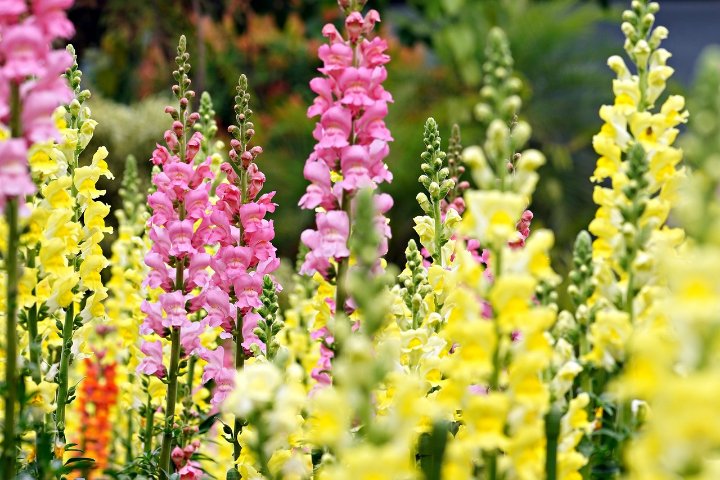
Snapdragons (Antirrhinum majus) are delightful annuals that bring charm and height to fall container gardens. Known for their unique, dragon-shaped blossoms that appear to “snap” open when squeezed, these flowers come in a rich palette of colors ranging from soft pastels to bold brights. Because Snapdragons thrive in cooler temperatures, they are perfect options for pots during the fall, continuing to bloom until frost arrives.
These plants prefer a sunny location and well-drained soil, thriving when watered consistently but not over-saturated. Snapdragons can grow quite tall, making them excellent candidates for the back of deeper pots or as focal points in mixed arrangements. Their upright habit allows for creative layering; they provide structure while framing shorter, trailing plants like Bacopa or Dichondra.
To enhance their vibrant beauty, create arrangements that highlight the contrast between the blocky shape of Snapdragons and the delicate nature of other fall blooms. Combine them with Pansies or ornamental kale for a visually stunning container that celebrates the season’s colors. The long blooming period of Snapdragons not only adds attractiveness to your pots but also encourages butterflies and other pollinators to visit, enriching the overall biodiversity of your garden space.
Sneezeweed
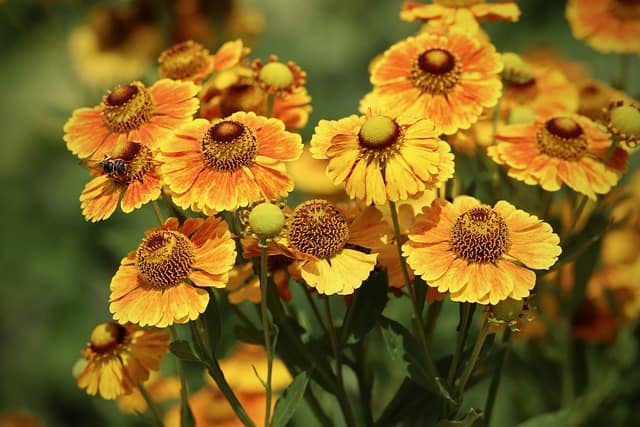
Sneezeweed (Helenium spp.) is a lesser-known yet exceptional addition to fall pots, famous for its warm, golden-yellow flowers that bloom during the later months of the growing season. Known for their cheerful appearance, these perennial plants can transform any container into a burst of color. Sneezeweed draws its name from the traditional use of dried flowers in herbal medicine, which supposedly caused sneezing when inhaled, but the beauty of this plant lies in its vibrant display rather than its history.
This flowering plant thrives in well-drained soil and prefers full sun, making it suitable for many fall container arrangements. The rich, daisy-like blooms not only captivate the eye but also attract various pollinators, supporting a healthy garden ecosystem. Sneezeweed’s unique, slightly drooping flowers add artistic flair to any pot, creating a casual yet elegant look.
When designing fall pots, consider pairing Sneezeweed with plants that complement its rich tones, such as Sedum or ornamental grasses like Miscanthus. This combination highlights the height and fullness of Sneezeweed while balancing the subtle shapes and colors of surrounding plants. Furthermore, their late-season blooming period ensures that your arrangements remain vibrant well into autumn, providing a warm and inviting atmosphere.
Sunflower (Helianthus annuus)
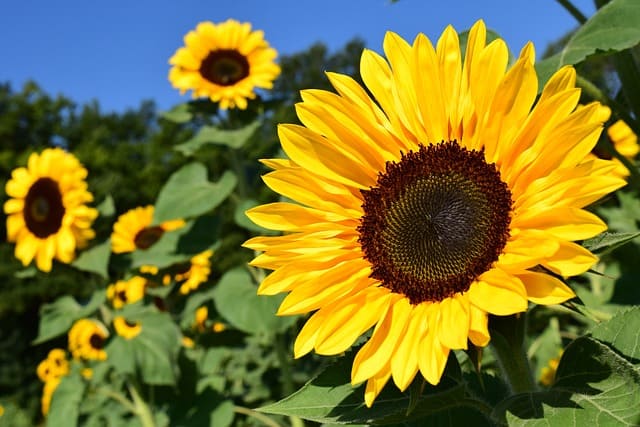
While sunflowers are often associated with the height of summer, certain varieties are perfect for fall planting and can add a striking focal point to your pots. Dwarf sunflowers, for instance, are compact yet bold, featuring vibrant yellow petals surrounding dark chocolate centers that can brighten any outdoor space. These cheerful blooms not only infuse your container garden with warmth but also remind us of sunny days, even as the weather begins to cool.
Sunflowers thrive in full sun and require well-draining soil to prevent root rot. They prefer regular watering, particularly during periods of dry weather. When planted in pots, dwarf sunflowers can create a stunning vertical element, providing a perfect backdrop for trailing plants or lower-growing flowers.
For a captivating fall display, consider incorporating sunflowers alongside fall-blooming plants like Asters or ornamental grasses, creating a delightful contrast between heights and textures. With bees and butterflies drawn to the bright blooms, sunflowers also invite beneficial pollinators into your garden, fostering a lively ecosystem. Their cheerful disposition can elevate any outdoor gathering, making them not just a plant, but also a source of joy and inspiration.
Sweet Alyssum
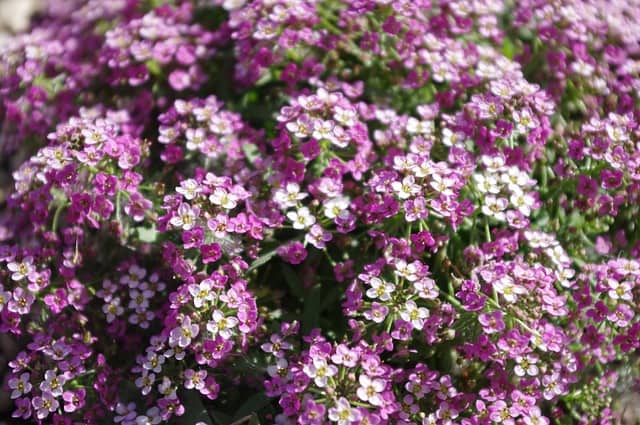
Sweet Alyssum (Lobularia maritima) is a charming, low-growing plant that exudes a delightful fragrance, making it an excellent addition to fall pot arrangements. Renowned for its clusters of delicate white, lavender, or pink flowers, Sweet Alyssum blankets its surrounding foliage in a soft carpet of color. During the cooler months, the plant flourishes, often blooming profusely even in chilly conditions, which makes it a favorite among gardeners looking for long-lasting color.
Ideal for pots, Sweet Alyssum performs well in well-draining soil and partial to full sun, although it can tolerate some shade. Regular watering is essential to keep the soil moist, especially in dry spells, as it helps promote healthy growth and abundant blooming. This resilient plant can also benefit from deadheading; removing spent flowers encourages a longer blooming season and a tidier appearance.
To maximize the visual impact of Sweet Alyssum in your fall pots, pair it with taller plants like Snapdragons or ornamental kale. The combination of heights creates depth and interest, while the aromatic blossoms provide an inviting scent that enhances the sensory experience of your garden. Additionally, Sweet Alyssum attracts beneficial insects, including ladybugs and lacewings, contributing to a balanced and healthy garden environment.
Swiss Chard
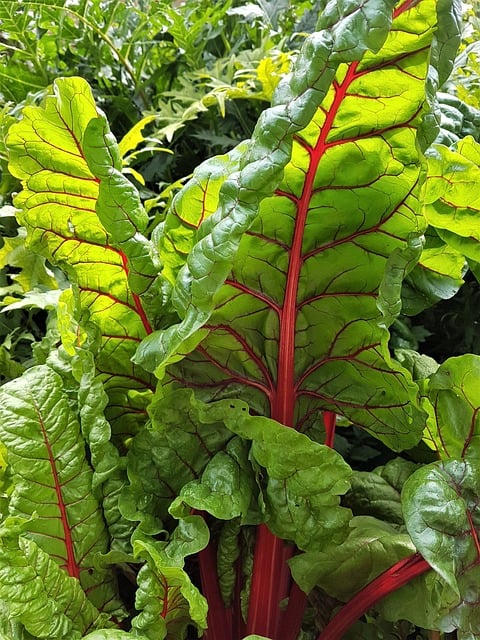
Swiss Chard (Beta vulgaris var. cicla) is a fantastic addition to fall container gardens, renowned for its vibrant, colorful stems and healthful leaves. This leafy green provides not just aesthetic value but also functionality, as it can be harvested and used in a variety of culinary dishes. Swiss Chard’s bright colors, ranging from ruby red to golden yellow, bring a pop of vibrancy and excitement to your pots, making it not only appealing to the eye but also nutritious for your table.
This hardy vegetable grows well in cooler temperatures, thriving in both full sun and partial shade. Swiss Chard prefers well-drained soil that is rich in organic matter; hence, adding compost when planting in pots can help establish robust growth. Regular watering is necessary to keep the foliage lush; however, it is important to allow the top inch of soil to dry out slightly between waterings to avoid waterlogged conditions.
When arranging Swiss Chard in your containers, consider combining it with ornamental plants such as Pansies or lush herbs like Basil. This creates a visually attractive, edible garden that not only looks beautiful but also provides fresh ingredients for your fall meals. The contrasting colors and textures will create an engaging focal point in your pot arrangements, and the harvestable leaves ensure that your outdoor beauty can also translate to culinary enjoyment.
Verbena (Verbena spp.)
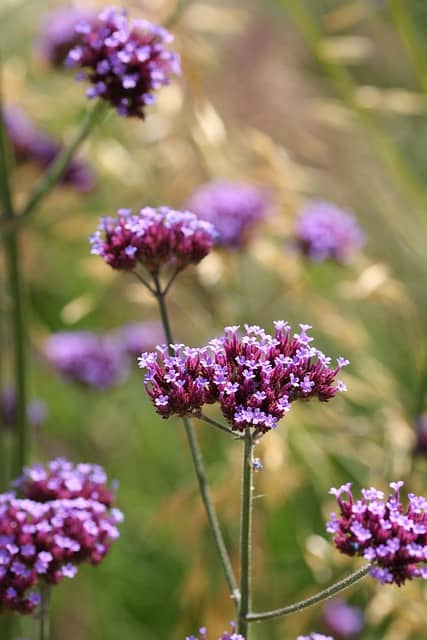
Verbena, with its sprawling habit and vibrant clusters of flowers, is a wonderful addition to your fall pots. This perennial favorite is known for its relentless blooming capabilities, as it continues to produce colorful flowers in shades of purple, pink, red, and white until frost. The small, densely-packed blooms create a striking display, and depending on the variety, Verbena can trail gracefully over the edges of your containers or stand upright for more dramatic height.
One of the key features of Verbena is its ability to attract pollinators, including bees and butterflies, making it an excellent choice for gardeners looking to support local ecosystems. Verbena thrives in full sun and well-drained soil, tolerating some drought once established, which makes it a low-maintenance option for busy gardeners. Regular deadheading will encourage continuous blooming and a neat appearance throughout the fall.
Design-wise, Verbena works beautifully in combination with other fall plants, particularly those with contrasting textures and heights. Pairing it with taller species like Snapdragons or ornamental grasses can create a visually stunning arrangement. The trailing varieties of Verbena can soften the edges of pots and create a lovely draping effect when cascading over the sides, providing a lush, informal look to your containers.
Zinnia
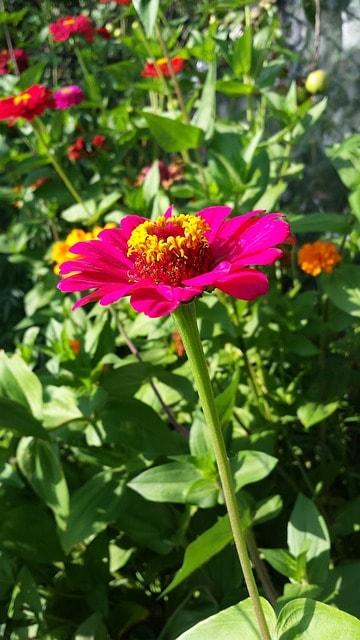
Zinnias are an extraordinary choice for fall pots, renowned for their bright, cheerful blooms that instantly capture attention. These annuals come in an array of colors—ranging from fiery red and sunny yellow to soft pink and deep purple—making them a versatile option for creating striking autumn displays. Zinnias are particularly resilient, thriving in warm conditions and blooming abundantly until frost, which means you can enjoy their vivid colors well into the fall season.
In terms of care, Zinnias prefer full sunlight and well-drained soil, making them ideal for pots that receive direct sun. They are relatively low-maintenance plants; just ensure they are watered regularly, especially during dry spells. To promote bushier growth and prolonged blooming, you can pinch back the tips of the plants.
For stunning combinations, consider mixing Zinnias with shorter plants such as Sweet Alyssum or low-growing Sedums. This pairing allows their bright colors to pop against the softer tones of the companions. Additionally, Zinnias make excellent cut flowers, allowing you to bring the vibrant energy of your pots indoors to enjoy as fresh arrangements. Their ability to attract butterflies and bees also enhances the dynamic nature of your garden, contributing to an ecosystem that thrives on biodiversity.





